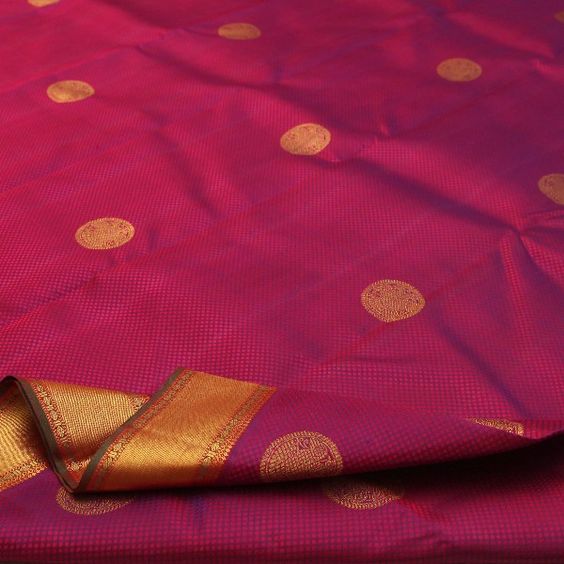
Sacred Seeds and Beads – the Rudraksha Motif on Handwoven Sarees
One of the most common motifs in handwoven sarees is the rudraksha or rudraksham - the rudraksha seed or bead. Many often pass it off as a geometric pattern or floral design. But pause. Look closely. The motif depicted is that of a rudraksha. Sacred, spiritual, medicinal and aesthetic – the rudraksha – one of the unique substances on the earth, carries with it a number of meanings and stories. Some of its stories unfurl in the different handwoven sarees. We gather these stories here, for you.
What is rudraksha?
The word Rudraksha is made of two words: Rudra, meaning Lord Shiva and Aksha, meaning eyes, hence the rudraksha signifies Shiva’s eyes. The rudraksha seeds are considered auspicious because of its association with Lord Shiva. They are believed to hold creative powers. It comes in many forms, from a single face to 21 faces, each used for different purposes.
Rudraksha trees or Elaeocarpus Ganitrus, as they are called, grows mostly at a certain altitude in the foothills of the Himalayan Terai region. The blueberries of the tree when dried become rudraksha. It is a one of a kind substance found like that on the planet.

Legend says
It is said that after killing Tripurasura who was terrorizing the three worlds, Lord Shiva closed his eyes and meditated for a thousand years, in order to destroy evil in the world. He became so engrossed and ecstatic in his meditation that tears of ecstasy started falling from his eyes on the earth. These tears turned into trees of rudraksha that started bearing the Rudraksha fruit.
There is yet another version of the legend that says that when Lord Shiva opened his eyes after thousand years, he became teary-eyed at seeing the suffering of the world and that’s when each of his tears that fell on the earth grew into a rudraksha tree.
Another legend says that when Goddess Parvati wanted to adorn herself with jewelry, Shiva gave her rudraksha beads to make her ornaments.
The religious and spiritual connotation
Rudraksha seeds have different purposes: spiritual, medicinal and protective. It is traditionally used as prayer beads in Hinduism, particularly Shaivism. An interesting reason for this: the rudraksha has an uneven surface with different faces. Using it as prayer beads leads to an acupressure-like feeling, which leads to calming the mind and body. Fundamentally people wore the rudraksha on their bodies because it cleanses and purifies the aura. Today, a lot of people around the world have started wearing the rudraksha for various reasons. Rudraksha is part of the Buddhist religion too. The Vaishna regions adopted rudraksha as representing the ten avatars of Vishnu.
Rudraksha woven in threads
Let us begin with a beautiful analogy as shared by The Timeless Appeal of the Indian Saree, an online community of textile lovers.

“Rudraksha beads are strung into the japamala or rosary and symbolizes the eternal rhythm and power of the whole cosmos, the compassion and peace of the universal forces and helps create a meditative state.
And so does weaving, the rhythm of warp and weft, the musical cadence of the most ancient technology, the beat of a weaver’s world; most beautifully captured in nirgun bhajans of Weaver poet Sant Kabir's 'Jheeni jheeni re chadariya' and packed into the folds of the weave, captured in the whorls of the rudraksha motif.
And when you wear a beautiful saree with rudraksh motif this Shivratri, feel protected that the power of the cosmos, and well wishes and the song of the weaver are with you.”
Source:(https://bit.ly/2IBb5lK)
Having the rudraksha motif on textiles is in a way making spirituality part of our daily lives. Just like anyone can wear the rudraksha beads, the motif is used in both, garments for men and women – sarees, dhotis, and angavastram.
The design of the Rudraksha bead is adapted in different textiles in multiple ways. Particularly a common motif in the weaves of the southern and eastern region of India. It is said to be one of the oldest motifs from Shaiva period and most popular along the Coromandel coast. The motif can be seen commonly on kanjeevaram silks, Gadwal, Chettinad weaves, Narayanpet, Bomkai, Bengal taant, Dharward sarees, and hand woven sarees of Orissa, as well as Sambalpuri weaves. Most commonly the design is seen in a repetitive pattern on the border of the saree and at the time on the pallu.
The boota or central part of the flower surrounded by petals is considered akin to a rudraksha. Sarees having this design central to the overall pattern are considered as rudraksha weaves.
Designing the motif – the intricacies
Different weavers and designers have adapted the rudraksha motif to different weaves. Oval or round, the motif is crafted in a number of designs. At times the faces give the motif geometric patterns, at times intricate designs are created to depict the markings of the rudraksha seeds and at times curly and curvy lines form the rudraksha motif.
For example, the rudraksha motif on a Sambalpuri weave is exceptionally gerometic, whereas the kanjeevaram weave with silk threads allows for a more intricately designed motif.
Rudraksha motif – inseparable from Kanjeevaram Sarees
In a research/thesis, researcher Jyoti Vastrad sites several references of scholars and experts who have studied different textiles and especially mentioned the rudraksha motif. The research studies the different process of weaving textiles and the changes that it has gone through over the years. Some references, particular to kanjeevaram sarees and rudraksha motifs are too interesting and deserve a mention here. Researcher Nadiger’s 1995 study elaborated the uniqueness of kanjeevaram sarees related to the weaving the solid border and the pallu. “'Korvai' is an elaborate process of interlocking individual warp yams with the pallav yarns resembling the border yarns. The pallav often runs up to 48" full of decorative details and finish. The body of the saree was either plain or with simple checks or most commonly with buttas. Rudraksham, vankis, and diamond motif are among the most common.”
Source:(https://bit.ly/2IAkyKe)
Depictions of rudraksha motif in weaves from other parts of India
Bansal and Phadke (1984) in a study on 'Handwoven sarees of Maharashtra' mentioned that the weaving of pure cotton sarees of Ahmednagar was introduced into the city by a rich Kolik of the Bhangria clan soon after the city was founded in the year 1499. The weavers purchased cotton yarn from Bombay, Coimbatore, and local markets. Motifs used in the border included gome, bugdi, veel bugdi, ruiful, kamal, rudrakshi, swastika, among others.
The ornamented Gadwal saree of Andhra Pradesh textiles adorned with rich and beautiful pallav. (Jacob and Bala 1999). Pallav and border consisted of pure silk and were attached separately to the body by 'Korvai' technique. Common motifs used in the sarees were 'vanki', 'muthu', running floral motifs and wavy pallav designs with muthu and stylized diamond motifs. This wavy portion was adorned with mango, muthu and rudraksha motifs in gold zari.
A reference to studies by Sanapapamma and Mahale (2001) about the 'Silk of Molakalmuru' revealed that geometrical, temple and intricate designs, and most commonly woven buttas were the mango, peacock, parrot, hamsa, lotus, diamond, rudraksha beads, Banaras, Venki, and Phoenix on both contrast and self-bordered sarees.
Source:(https://bit.ly/2IAkyKe)
The saga continues…
The next time you purchase a saree, make sure you pay attention to the motifs and designs. They carry intrinsic meanings that can add much more than the aesthetic value to your daily life. Enrich your life with these fine, beautiful meanings.
